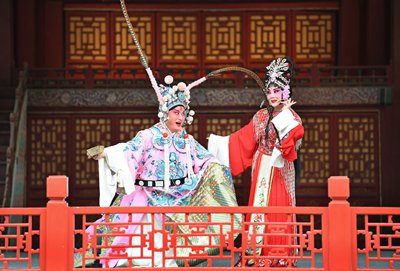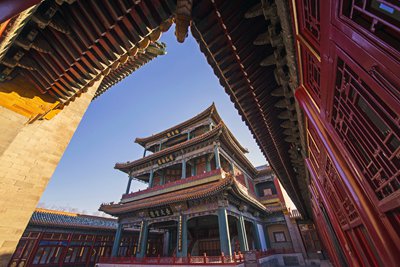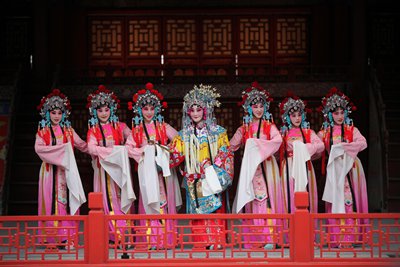"US President Donald Trump is not easy to please," Shan Jixiang, the director of the Palace Museum, joked at the opening ceremony for a performance of traditional Hui Opera at the Forbidden City on Saturday.

Opera singers perform a traditional Hui Opera at the Palace Museum on Saturday. (Photos: VCG)
"But he applauded five times while watching Chinese Opera performance The Monkey King."
Traditional Chinese Opera has long been regarded as a cultural symbol of the country, with its classic singing styles, historical costumes and moving folk stories.
To celebrate China's Cultural Heritage Day on Saturday, the museum invited a popular Hui Opera troupe to perform at the Forbidden City's Changyin Ge (Belvedere of Pleasant Sounds).
The predecessor to Peking Opera, Hui Opera is one of the most representative of all Chinese opera forms.
As its name indicates, Hui Opera originated in Huizhou, East China's Anhui Province. It appeared during the middle of the Ming Dynasty (1368-1644) and became popular during the Qing Dynasty (1644-1911), especially during the reign of the Qianlong Emperor, a time when the opera received the patronage of the imperial family.
"This is the third time that the Belvedere of Pleasant Sounds has been put into use since it was restored for opera performances in September of last year," Shan told the Global Times.

The Belvedere of Pleasant Sounds at the Palace Museum
Main stage
Located in the eastern section of the Palace Museum, the belvedere is part of the Palace of Peace and Longevity and consists of a three-story stage that was rebuilt during the reign of the Ming Dynasty Emperor Jiajing (1521-67). There were once 11 such stages for opera performances inside the Forbidden City, but the belvedere is the largest and most intact one.
Auspicious names have been given to each level of the stage, starting with fu (fortune) at the top, lu (salary) in the middle and shou (longevity) at the bottom.
During festivals and the birthdays of members of the royal family, famous opera troupes would be invited to perform at the belvedere for the emperor.
To ensure performances ran as smoothly as possible, bridges were built to connect each stage and a small lifting platform was installed so that actors playing immortals could "drop from the sky" in dramatic fashion.

A Hui Opera troupe performs at the Palace Museum
Other stages
The extreme popularity of opera among the imperial family led to the construction of nearly a dozen venues throughout the imperial palace. The Juanqin Zhai, or Studio of Exhaustion from Diligent Service, located at the Ningshou Gong (Palace of Tranquil Longevity) boasts a small indoor stage shaped like a pavilion with a pointed roof.
To the north and south side of the stage are two partition walls which were used to block noise and provide a private environment for audiences. There is also an elegant moon gate on the south side of the stage that spices up the room with its elaborate design. The ceiling and walls are decorated with colorful paintings and Chinese wisteria, a climbing vine native to China. The paintings are of a bamboo fence, which goes with the artificial bamboo fence that is on top of the stage and forms a peaceful and harmonious atmosphere.
The Qing Dynasty Guangxu Emperor (reign: 1875-1908) enjoyed watching operas at this venue quite often. According to historical records, Guangxu would bring with him a tiny gong that he enjoyed beating in time with the music played during an opera. Occasionally, officials were also asked to join in by bringing their own gongs.
The second largest stage in the Palace Museum is a single-story stage located in the Shufang Zhai (Studio of Cleansing Fragrance). On the third day of the Chinese New Year, the Qianlong Emperor would treat officials by inviting them to watch opera at this venue. Just like the belvedere, it had a lifting platform, but it also came with a well located under the stage that added an echoing effect to performances.
The introduction of Hui Opera to Beijing dates back to 1790, when the Qianlong Emperor was preparing for his 80th birthday celebrations.
That year four of the most famous Hui Opera troupes were invited to travel all the way to Beijing to perform.
The emperor enjoyed the performances so much that Hui Opera performances soon became commonplace at the imperial palace.
Later during the reign of the Xianfeng Emperor (1850-61), Hui Opera gradually evolved into Peking Opera as it absorbed features from Hubei Province's Han Opera and other regional operas.


